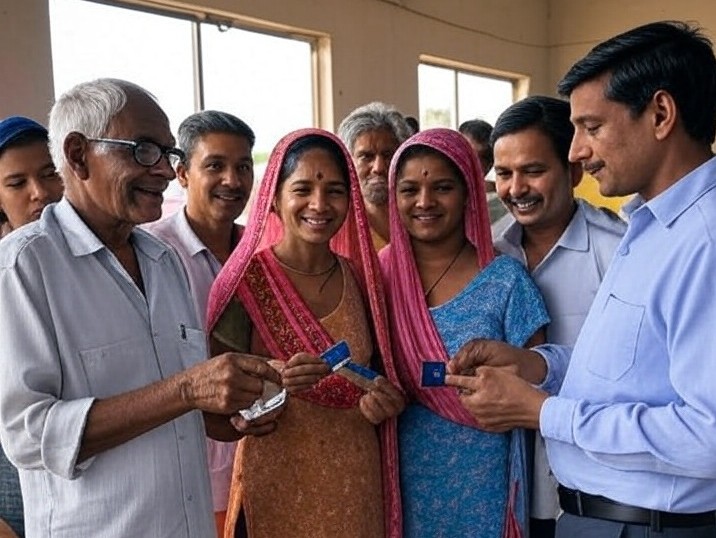The Pradhan Mantri Jan Dhan Yojana (PMJDY), launched on August 28, 2014, by Prime Minister Shri Narendra Modi, stands as a monumental step toward financial inclusion in India. Announced during his Independence Day speech on August 15, 2014, PMJDY was envisioned as a “festival to celebrate the liberation of the poor” from financial exclusion. Designed to provide universal access to banking services, the scheme has brought millions of unbanked individuals into the formal financial system, earning recognition as one of the world’s largest financial inclusion programs. As of 2025, PMJDY has transformed lives, empowered marginalized communities, and strengthened India’s economy. This article provides a comprehensive overview of the scheme, its objectives, features, achievements, challenges, and its enduring impact.
Genesis and Objectives
PMJDY was launched to address the stark reality that a significant portion of India’s population lacked access to basic banking services. At the time, millions of households, particularly in rural and low-income areas, were excluded from the formal financial system, relying on informal sources like moneylenders for credit. The scheme’s core objective is to ensure comprehensive financial inclusion by providing every unbanked household—and later every unbanked adult—with access to a bank account, affordable financial products, and financial literacy.
The key objectives of PMJDY include:
- Banking the unbanked: Ensuring at least one basic savings account per household, later extended to every unbanked adult.
- Securing the unsecured: Providing access to insurance and pension products.
- Funding the unfunded: Facilitating credit facilities for small entrepreneurs and households.
- Promoting financial literacy: Educating citizens about financial products and services.
- Enabling Direct Benefit Transfer (DBT): Streamlining government subsidies and welfare payments to reduce leakages.
Key Features of PMJDY
PMJDY is designed to be inclusive, accessible, and technology-driven. Its standout features include:
- Zero Balance Accounts:
- Accounts can be opened with no minimum balance, making banking affordable for all. However, minimum balance requirements may apply if a cheque book is issued.
- RuPay Debit Card:
- Every account holder receives a free RuPay debit card with inbuilt accident insurance:
- ₹1 lakh for accounts opened before August 28, 2018.
- ₹2 lakh for accounts opened on or after August 28, 2018.
- Every account holder receives a free RuPay debit card with inbuilt accident insurance:
- Overdraft Facility:
- Eligible account holders can access an overdraft of up to ₹10,000 after six months of satisfactory account operation. For Aadhaar-linked accounts, an overdraft of up to ₹5,000 is available, subject to bank discretion.
- Life Insurance Cover:
- Accounts opened between August 15, 2014, and January 26, 2015, are eligible for a ₹30,000 life insurance cover, subject to specific conditions.
- Mobile Banking:
- Accounts support mobile banking via USSD (Unstructured Supplementary Service Data), enabling transactions on basic feature phones.
- Direct Benefit Transfer (DBT):
- PMJDY accounts are linked to DBT, ensuring that government subsidies and welfare benefits are credited directly, minimizing leakages.
- Financial Literacy:
- The scheme promotes financial education at the grassroots level to encourage informed financial decision-making.
- Micro Insurance and Pension:
- In its second phase, PMJDY facilitates access to micro-insurance and pension schemes like Swavalamban through Business Correspondents.
- Kisan Credit Cards (KCC):
- KCCs are integrated with the RuPay platform to enhance accessibility for farmers.
Eligibility and Documentation
PMJDY is open to all Indian citizens, with simplified eligibility and documentation processes:
- Eligibility:
- Individuals aged 10 years and above (minors require a guardian).
- Indian citizens without an existing bank account are prioritized.
- Joint accounts are permitted.
- Documents:
- With Aadhaar: Only an Aadhaar card/number is required, serving as proof of identity, address, and age.
- Without Aadhaar: Any Officially Valid Document (OVD) like a voter ID, driving license, PAN card, passport, or NREGA card is accepted.
- Small Accounts: For those without OVDs, small accounts with restricted transaction limits (e.g., ₹1 lakh annual credit) can be opened for 12 months, extendable upon applying for an OVD.
How to Open a PMJDY Account
Opening a PMJDY account is straightforward:
- Visit a bank branch on the Core Banking System (CBS) or a Business Correspondent (Bank Mitra) outlet.
- Obtain and fill the PMJDY account opening form, available at banks or on the official website (pmjdy.gov.in).
- Submit the form with required documents (Aadhaar or OVD) and a mobile number/email ID.
- Upon verification, the account is activated, and a RuPay debit card is issued.
The Jan Dhan Darshak App helps users locate nearby banking touchpoints, making the process even more accessible.
Implementation Framework
PMJDY operates in a Mission Mode with a robust monitoring structure:
- Central Level: The Finance Minister heads the mission, supported by a Steering Committee and a Mission Director.
- State and District Levels: Implementation committees ensure progress at local levels.
- Bank Mitras: Over 13.55 lakh Business Correspondents deliver branchless banking services, particularly in rural areas.
- Technology: The scheme leverages mobile banking, CBS, and Aadhaar integration for efficient service delivery.
Initially implemented in three phases, PMJDY shifted its focus from “every household” to “every unbanked adult” after August 14, 2018, with enhanced features like higher overdraft limits and accident insurance.
Achievements and Impact
PMJDY has achieved remarkable milestones, reshaping India’s financial landscape:
- Massive Account Openings:
- Over 55.31 crore accounts have been opened as of recent data, with 55.5% women beneficiaries and 67% accounts in rural/semi-urban areas.
- By August 2023, the scheme crossed 50 crore accounts.
- Deposits:
- Total balances in PMJDY accounts reached ₹2,62,008.82 crore by 2025, doubling from ₹1 lakh crore in July 2019.
- During demonetization (November 2016), balances surged by ₹270 billion (US$3.2 billion) in two weeks.
- RuPay Cards:
- Over 34 crore RuPay debit cards have been issued, providing free accident insurance.
- Overdraft Utilization:
- By May 2016, 1.9 million households availed overdraft facilities worth ₹2.56 billion (US$30 million).
- Direct Benefit Transfer (DBT):
- DBT through PMJDY accounts has saved the government ₹3.48 lakh crore by plugging subsidy leakages.
- As of February 2024, DBT worth ₹34 lakh crore was facilitated, enabling additional welfare funding.
- COVID-19 Relief:
- During the pandemic, PMJDY accounts were used to disburse ₹500 per month for three months to women account holders under the Pradhan Mantri Garib Kalyan Yojana.
- Guinness World Record:
- PMJDY earned a record for opening 18,096,130 accounts in one week (August 23–29, 2014).
- Gender and Regional Equity:
- The scheme has empowered women and rural populations, with over 56% female account holders.
Benefits to Society
PMJDY has delivered tangible benefits to individuals and the economy:
- Financial Inclusion: Millions have been integrated into the formal banking system, reducing reliance on informal credit.
- Free Insurance: Accident and life insurance covers provide a safety net for low-income families.
- Savings and Credit: Interest on deposits and overdraft facilities encourage financial discipline and emergency funding.
- Transparency: DBT ensures welfare benefits reach intended beneficiaries, minimizing corruption.
- Economic Growth: Formalized savings and increased banking penetration have boosted economic activity.
- Complementary Schemes: PMJDY supports programs like Sukanya Samriddhi Yojana and PM Swanidhi Yojana.
Challenges and Criticisms
Despite its success, PMJDY faces challenges:
- Inoperative Accounts: As of January 2021, only 359.6 million of 417.5 million accounts were operative, indicating dormant accounts.
- Duplication: Some individuals with existing accounts opened PMJDY accounts for benefits, violating RBI guidelines.
- Bank Burden: Zero-balance accounts and free services have strained public-sector banks’ resources.
- Limited Insurance Scope: The ₹30,000 life insurance cover is restricted to a specific period and has a five-year validity.
- Overdraft Access: Bank discretion limits overdraft availability for some eligible account holders.
Support Infrastructure
PMJDY is supported by robust infrastructure:
- Toll-Free Number: 1800-102-7788 assists customers with queries.
- Bank Mitras: Business Correspondents bridge the gap in unbanked areas.
- Jan Dhan Darshak App: Helps locate banking touchpoints and supports the government in identifying unbanked villages.
Recent Milestones
- 10-Year Anniversary (2024): PMJDY marked a decade of impact, with posts on X celebrating its role in India’s economic transformation.
- Economic Savings: DBT integration has saved ₹1.70 lakh crore to ₹3.48 lakh crore, enabling reinvestment in welfare schemes.
- Interim Budget 2024: Finance Minister Nirmala Sitharaman highlighted PMJDY’s role in facilitating ₹34 lakh crore in DBT, underscoring its systemic importance.
Conclusion
The Pradhan Mantri Jan Dhan Yojana has redefined financial inclusion in India, bringing over 55 crore people into the banking system, with deposits exceeding ₹2.62 lakh crore. By empowering women, rural communities, and the underprivileged, PMJDY has laid the foundation for a financially inclusive and equitable India. Its integration with DBT, technology-driven approach, and focus on financial literacy have made it a global model, as evidenced by its Guinness World Record. While challenges like inoperative accounts persist, the scheme’s transformative impact is undeniable. As PMJDY continues to evolve, it remains a cornerstone of India’s journey toward economic empowerment and social justice.















Leave a Reply